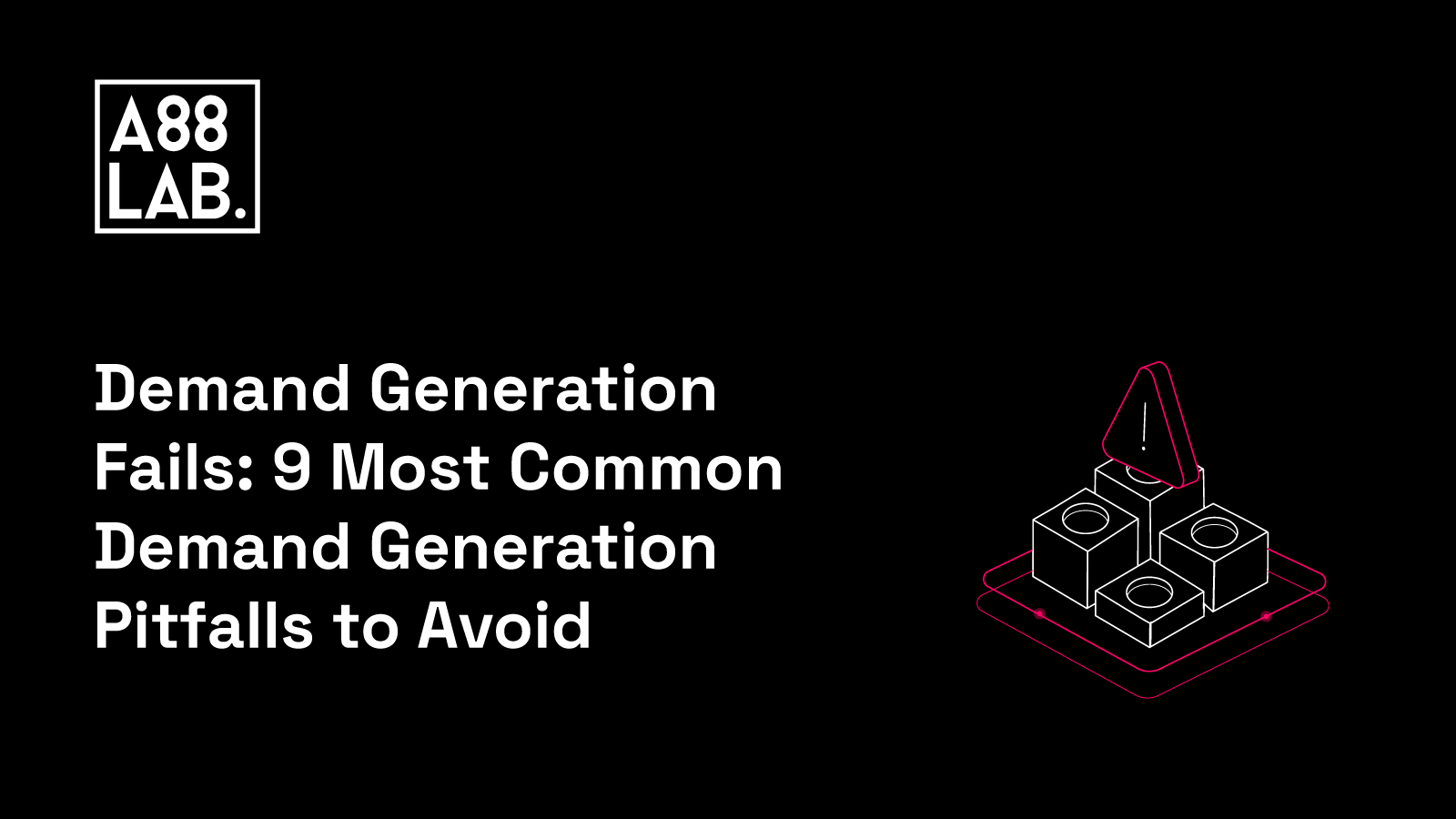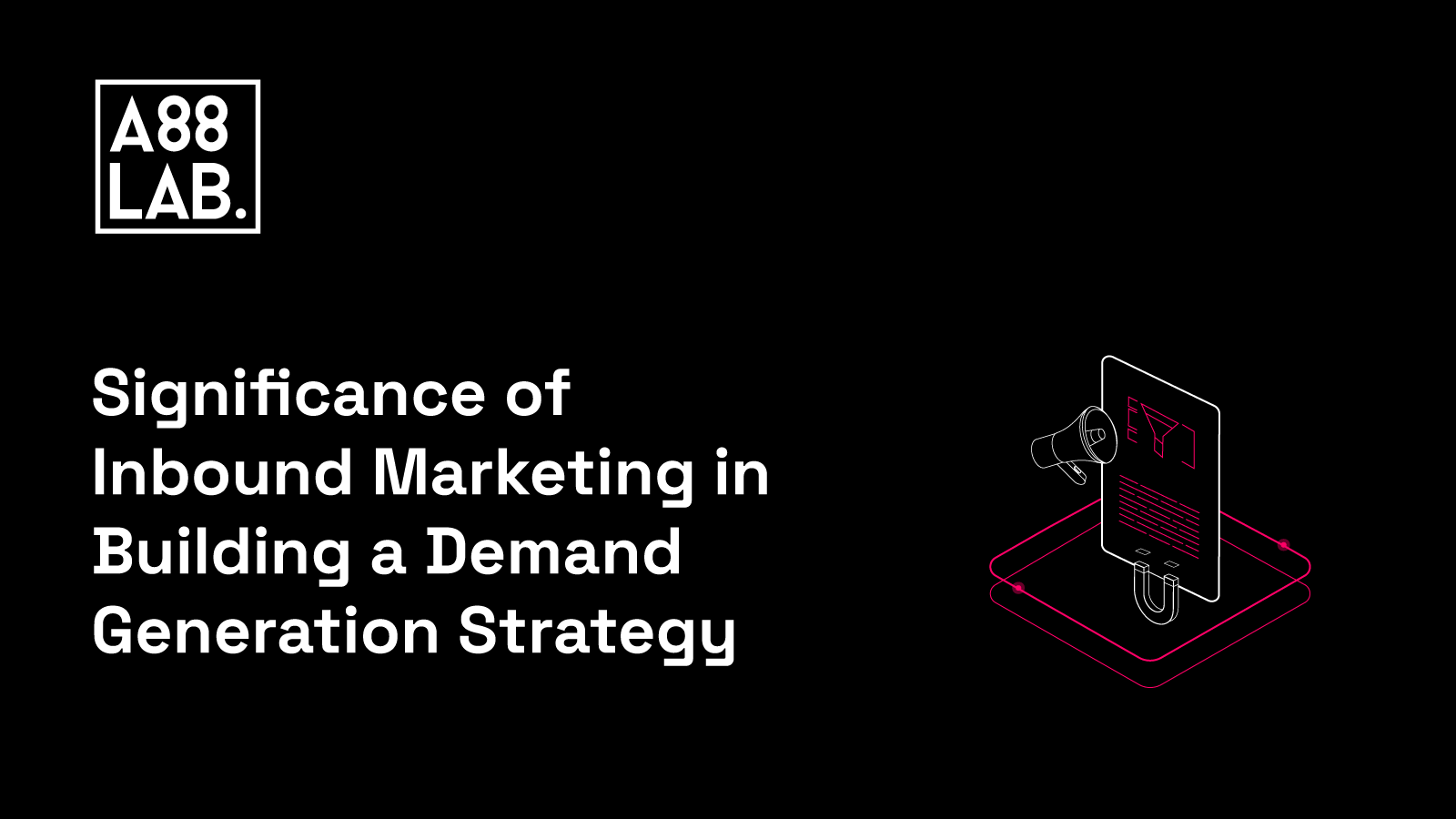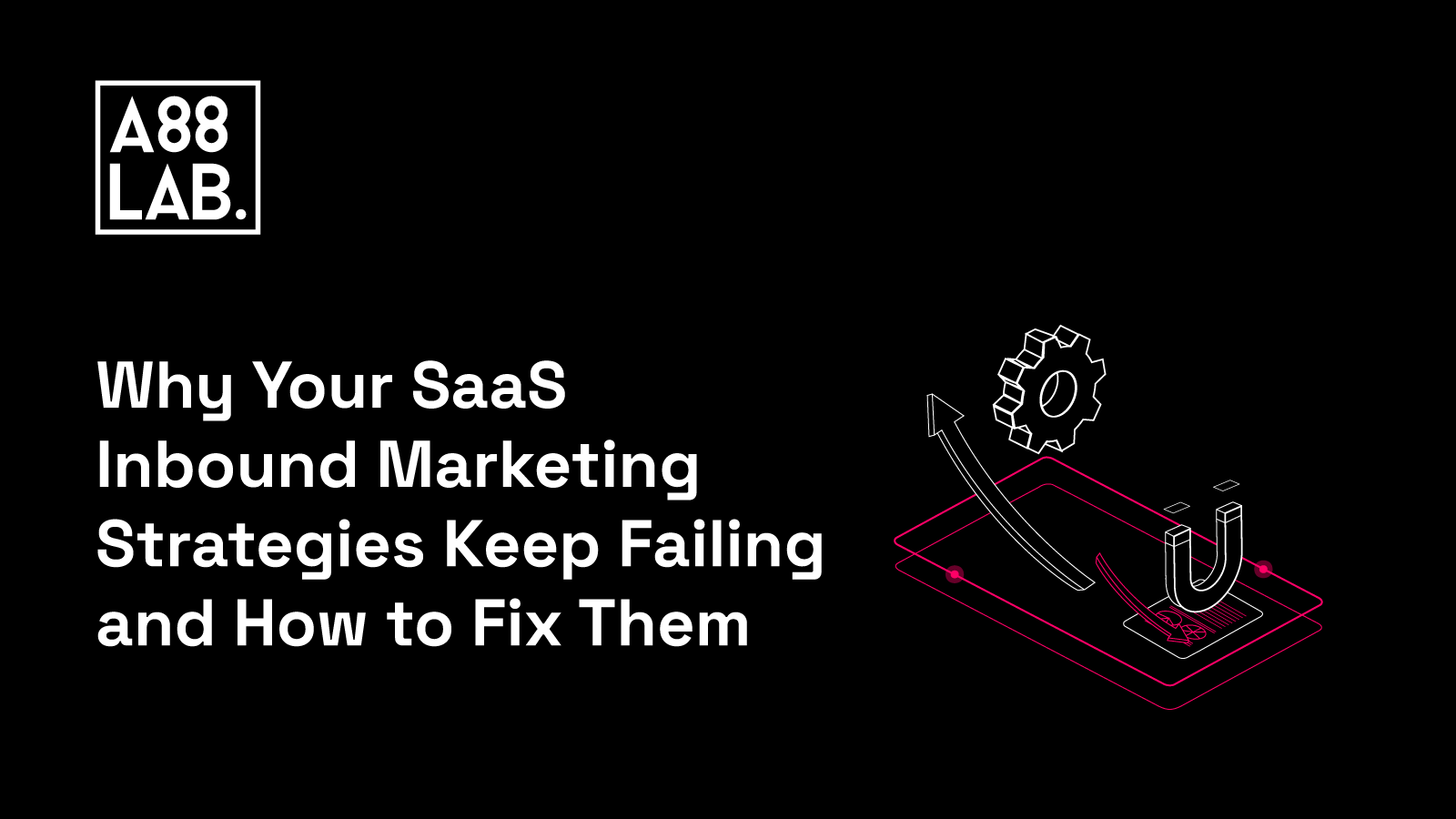In today's world of distraction and noise, capturing interest and demand for your SaaS is a real challenge. Everywhere you look, SaaS marketers struggle to generate demand results, brand recognition, and user loyalty.
Demand generation efforts often fail when marketers prioritize their own goals, such as the number of leads, followers, and clicks, over customer-centric goals of providing a great product and customer experience. This leads to misaligned strategies and tactics that drive short-term success but don't serve the long-term needs of the business.
Getting great results from demand generation takes more than just putting your product in front of your target audience. You need tools, resources, ideas, and strategies to prove to your prospects that you can solve their problem, add value, and make their lives easier. But before you can do that, it's essential to identify the most common demand generation pitfalls so you can prevent them from happening in your campaigns.
In this blog post, we'll discuss the nine most common demand generation pitfalls and share some of the best approaches to avoid them and scale your demand generation efforts.
Pitfall #1. Not Finding the Right Balance Between Product-Driven and Emotional Connection Content
When creating content that will generate demand, the common mistake SaaS companies make is focusing only on product descriptions, whitepapers, factsheets etc. and neglecting the emotional and human aspects of their message.
Product-led content has become all the rage in recent years, but it's not enough to build a strong demand generation strategy. You need content that solves problems and drives users towards your product by creating an emotional connection and trust.
Achieving the right balance between product-driven and emotional connection content requires a deep understanding of your customers and their needs while at the same time understanding the unique features of your product that make it desirable to them.
Here are some tips to help you with it:
-
Understand your audience: Before creating content, research your target audience and their pain points, goals, and communication preferences. Use this information to craft messaging that resonates emotionally while showcasing the value of your product. Perform surveys, questionnaires, request data from sales, listen to sales calls, and try to identify what your target audience really wants.
-
Use storytelling: Storytelling is one of the most effective ways to create an emotional connection with your customers. It adds a human touch to your product and helps them feel part of your brand experience.
-
Include data: While emotional connection is important, it's also essential to back up your messaging with data. Use statistics, case studies, and customer testimonials to show the tangible value of your product. This will help create a stronger connection with your prospects and give them useful insights into how your product can help them.
-
Use a conversational tone: Avoid using technical or jargon-heavy language in your content. Instead, use a conversational tone that reflects your audience's communication preferences and helps them connect with your message.
Product-led content on its own won't be enough to make a lasting impression on your prospects. On the other hand, emotional connection content without the product-led elements won't be enough to help you achieve your demand generation goals either. The key is to find a balance between the two and use them together to create an effective demand generation strategy.
Pitfall #2. Poor Data Management
60% of brands do not measure the financial cost of poor-quality data. Poor data management can lead to a host of problems, such as:
-
Misleading information about potential customers and the market can result in ineffective marketing strategies and missed opportunities.
-
Failing to identify trends in the industry can lead to a lack of innovation and a decline in competitiveness.
-
Poor data management can leave SaaS companies vulnerable to security breaches and other cyber threats, ultimately damaging their reputation and customer trust.
One of the best ways to overcome this is by appointing a chief data officer responsible for maintaining data quality. They can help you oversee data collection, storage, and analysis to ensure its accuracy, completeness, transparency, and consistency.
Using automated solutions such as CRM software can streamline customer data, making it easier to access and analyze. Additionally, it is important to constantly monitor data quality to identify any discrepancies or errors that could negatively impact the business.
By implementing strong data management practices, you can ensure that your demand generation efforts are well-informed and effective. This, in turn, can lead to increased customer loyalty, higher retention rates, and, ultimately, greater business success.
Pitfall #3. Using Gated Content
Using gated content can be a double-edged sword for SaaS. While it's commonly used to capture leads as one of the lead generation tactics, it also comes with its fair share of challenges when it comes to generating demand, and it can essentially do more harm than good.
For a demand generation strategy to work, you have to show expertise, build credibility, and earn the trust of potential customers before they are willing to commit to a purchase. But, gated content essentially creates a barrier that makes it more difficult for customers to get the information they need to make an informed decision.
Your audience will only be able to access it if they are willing to give away their contact information, which can put them off from visiting or engaging with your website. It's important to understand that in today's digital landscape, users expect free and unrestricted access to content on websites.
In a way, gated content limits the effectiveness of your demand generation, so it's important not to overuse it. Instead, offer truly valuable ungated content that will help you foster relationships with your customers and be worth sharing with others. This will ultimately maximize the reach and effectiveness of your marketing efforts and build a loyal customer base over time.
Pitfall #4. Stopping Demand Generation Efforts Right Before They Start Showing Results
Demand generation is a long-term strategy that requires patience and consistency. Ending demand generation efforts too soon can be a significant pitfall, especially when businesses haven't had the chance to see the first results yet.
Demand generation is not a one-size-fits-all approach, and it often takes time to find the right mix of tactics that work for your business, which means it often takes time to start seeing the first results.
There are several key reasons why SaaS quit their demand generation efforts too soon:
-
Unrealistic expectations: Demand generation is a marathon, not a sprint. If you launch a new demand generation campaign and don't see an immediate increase in leads and sales, that doesn't mean your campaign is not working. Building brand awareness, nurturing leads, and establishing trust with potential customers takes time, and results may not be visible in the short term.
-
Missed opportunities: By stopping demand generation efforts too soon, businesses lose the chance to engage with potential customers who may have been in the early stages of their buying journey and needed more time and touchpoints to convert.
-
Long sales cycles: Many SaaS companies struggle with long sales cycles, especially for complex or high-value products. Demand generation activities help keep potential customers engaged throughout these extended periods. Deciding to end your demand gen early on can lead to abandonment by prospects progressing through the sales funnel.
-
Brand equity and trust: If SaaS businesses stop their demand generation efforts early, it might harm the brand's long-term growth potential. Moreover, competitors who maintain their demand generation efforts can gain an advantage, leading to lost market share and becoming less relevant in the SaaS industry.
Pitfall #5. Measuring Demand Generation Success With Lead Generation KPIs
While lead generation focuses on the bottom of the funnel, demand generation takes a full-funnel perspective, assigning specific KPIs to every customer journey stage. This approach ensures that all prospects are valued and their needs are met in a personalized manner.
Unfortunately, many SaaS companies focus solely on lead generation KPIs that target the lower funnel, resulting in short-term gains at the expense of long-term sustainability.
Instead of relying on actionable demand generation metrics like conversion rate, cost per lead, or customer acquisition cost that show how successful your demand gen strategy is, SaaS companies often make the mistake of relying on metrics like:
-
Bounce rate: While it is a useful indicator of how engaging your content is, it does not provide a complete picture of your visitors' behavior or intent. For example, a visitor may have found the information they sought on the landing page and left, leading to a high bounce rate. However, they may have also converted and become valuable leads.
-
Lead value and quality: By focusing solely on the number of leads and conversions, SaaS companies may miss out on opportunities to improve their overall business performance and profitability. Instead, use a combination of metrics that provide a more comprehensive view of demand generation success.
-
Website traffic: While monitoring website traffic is a valuable metric for lead generation, SaaS companies should not rely on it when measuring demand gen successes. Website traffic can be influenced by factors such as SEO and advertising, which may not necessarily translate to actual conversions and revenue.
-
Sales Qualified Opportunities (SQOs): SQOs only measure leads likely to convert into paying customers rather than the overall effectiveness of demand generation efforts.
Measuring demand generation success goes beyond lead generation metrics. By adopting a comprehensive approach to demand generation, you can nurture your prospect through each stage of the funnel and, ultimately, build long-term loyalty and revenue growth.
Pitfall #6. Poor and Not Well-Defined ICP
Another potential block to your demand generation efforts is having a poorly defined Ideal Customer Persona (ICP).
Not having a well-defined ICP will only lead to offering weaker unique values, and you will end up not resonating as well with those buyers who are the best fit for your organization.
Ultimately, you're not doing yourself any favors trying to resonate with as many markets as possible. The most common mistakes we can recognize in SaaS companies that lead to poorly defined ICP are:
-
Being too broad: Creating overly broad personas that don't target your ideal audience can lead to generalized content that doesn't attract the right people. Instead, focus on creating specific personas that target the people who are most likely to benefit from your product.
-
Assume your perspective is the same as your customers: This will only lead to ineffective solutions that don't meet their needs. Talk to your customers to find out what their real problems are and how they are currently trying to solve them.
-
Create unrealistic personas: Not taking a closer look at your analytics and creating unrealistic personas based on assumptions can lead to ineffective marketing campaigns. Take a closer look at your analytics to get a thorough understanding of who your current and prospective buyers are.
-
Be hyper-focused on your product: Being hyper-focused on your product without educating your customers on your company's areas of expertise can decrease the likelihood of them choosing your product to solve their problems. Educate your customers on your company's expertise to build a positive relationship with them.
-
Taking action too early: Taking action too early without getting your buyer personas right can waste valuable time and resources.
If you're looking to generate demand, you must clearly understand your ideal customer profile. SaaS companies should take the time to develop a detailed ideal customer profile to maximize their marketing efforts and generate more leads.
Pitfall #7. Not Leveraging ABM
ABM is an approach that tailors marketing efforts to the specific needs of high-value accounts. Not allocating a budget for personalized campaigns, account research, technology investments, and data analytics can also affect ABM's success. Without adequate funding, businesses may struggle to secure the necessary resources to implement effective ABM strategies.
On the other hand, relying solely on popular CRM and marketing automation tools that lack ABM features can limit the effectiveness of your ABM efforts.
Finally, failing to define account-level metrics, implement analytics tools, and establish precise attribution models can hinder the ability to measure ABM success and build a case for more budget in the future.
Steps you need to take to effectively leverage ABM include:
-
Collect relevant data
-
Create a targeted marketing plan to engage decision-makers
-
Validate lead data
-
Regularly evaluate performance
Pitfall #8. Optimizing for Vanity Instead of Business Metrics
When it comes to generating demand for SaaS products metrics like website traffic volume or email open rates may look impressive but often provide lack of meaningful insights into the success of your marketing efforts.
Measuring the success of your SaaS while relying solely on vanity metrics is misleading and oversimplified.
Examples of these metrics may include:
-
Numbers of page visitors without knowing from which source the traffics lands on the page
-
Total downloads, installations, or registered users
-
Number of app conversions
We’ve seen more than once how focusing too much on vanity metrics can lead to a false sense of success and prevent SaaS companies from identifying and addressing the root causes of low conversion rates or customer churn. The sooner you start prioritizing actionable metrics that directly impact your business goals, the better.
Here are some examples of business metrics to keep an eye on:
Customer acquisition cost (CAC)
When it comes to demand generation campaigns one of the most important things is if they generate revenue or not. Your CAC metrics tells you how much you spent to acquire a single paying customer from a specific demand generation campaign. Knowing this valuable information can help you in understanding what further steps you need to take to cut off those CAC costs.
Customer Lifetime Value (CLV)
Demand generation is all about building meaningful relationships with your customers. CLV by calculating the average profit each customer can bring throughout their entire relationship with your business, can help you make informed decisions on how to best engage your costumes and effectively manage those relationships. It gives you insights if there is any room for improvement or not. To effectively measure CLV calculate the average purchase value, then multiplying that number by the average purchase frequency rate.
Cost Per Lead
Cost per lead tells you how efficient your demand generation campaign is.This metric helps determine the amount you need to invest to maintain a steady flow of leads. Additionally, setting a limit on your cost per lead will prevent you from overspending on lead acquisition and ensure that you are receiving a return on your investment. Always consider this metric when planning new demand generation campaigns and calculating your return on investment.
Average Deal Size
Understanding your average deal size is crucial for predicting revenue from demand generation campaigns and identifying which customer segments to focus on. Additionally, analyzing the average deal size of each marketing channel provides a more detailed perspective on your return on investment (ROI)
Return On Ad Spend (ROAS)
By analyzing ROAS, companies can determine which advertising methods are successful and improve future marketing efforts. Insights from ROAS, combined with customer lifetime value, can inform future budgets, strategies, and overall marketing direction. By keeping accurate tabs on ROAS, SaaS companies can make informed decisions about where to invest their ad dollars and how to become more efficient in demand generation.
By focusing on these metrics and taking action to improve them, SaaS companies can generate more meaningful demand and drive sustainable growth.
When it comes to SaaS generating demand, reporting vanity metrics is simply not enough. Whether your business is succeeding or facing some challenges it's important to provide accurate and truthful reports on the results of your team's efforts. By focusing on actionable metrics, you can identify areas for improvement and take the necessary steps to enhance performance.
Pitfall #9. Using All Channels at the Same Time
To avoid making your demand generation funnel too complex, it's best to start small, focusing on 2 or 3 content distribution channels at a time. Starting small, testing, and scaling what works while discontinuing what doesn't is a highly effective approach in demand generation. This strategy allows you to be more efficient, adaptive, and focused on achieving your goals.
Remember that each channel requires proper effort, time, and energy. Focusing on all of them simultaneously will lead to sloppy demand generation results.
Here is how to start small and work your way up to achieve success:
-
Content marketing: Start with regularly posting blogs on your website and focus on creating high-quality, informative, and engaging content that addresses your target audience's pain points. Use SEO techniques to ensure your content is visible to potential customers.
-
Email marketing: Create a lead magnet, such as an ebook or whitepaper, that addresses a specific problem your target audience faces. Offering the lead magnet in exchange for their email address allows you to nurture those leads with relevant content and offers.
-
Social media marketing: Start by creating profiles on the most popular social media platforms like Facebook, Twitter, and LinkedIn. Share engaging content that provides value to your target audience and encourages them to interact with your brand.
Conclusion
Demand generation has always been a crucial strategy for SaaS companies. By implementing demand generation techniques, SaaS companies can increase their product awareness, generate interest, and build strong customer relationships, ultimately achieving the desired results.
Although demand generation has numerous benefits, many SaaS companies tend to make conscious or unconscious mistakes, which can negatively impact their business. Recognizing these mistakes early and taking steps to overcome them is vital to successful demand generation efforts.
.png)


